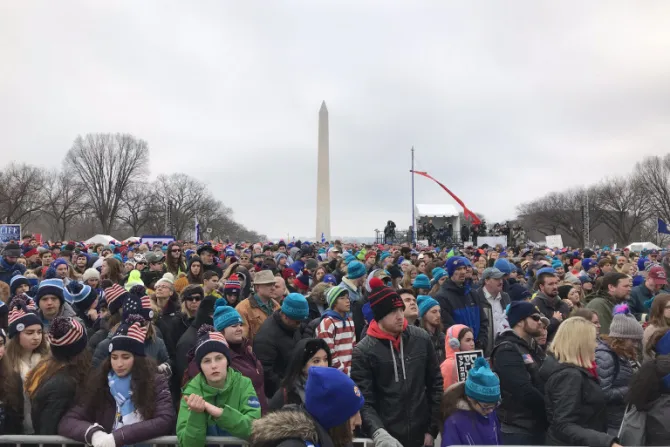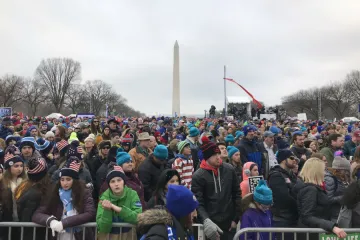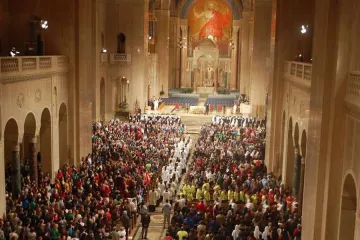Washington D.C., Jan 21, 2019 / 13:28 pm
A wave of media attention engulfed this weekend a group of students who attended last week's annual March for Life in Washington, DC. The students, most of whom attend Catholic high schools in Kentucky, were accused on Saturday of harassing and taunting a Native American drummer, but subsequent revelations revealed a decidedly more complicated picture.
Videos began to circulate on Saturday that depicted portions of a Jan. 18 incident close to the Lincoln Memorial, in which students who had attended the March for Life were part of a confluence of demonstrators near the Memorial, some from a Washington-based religious group called the Black Israelites, and some from the Indigenous Peoples' March, which took place in Washington on the same day as the larger March for Life.
Initially, the portions of the video that emerged, and quickly went viral, depicted a crowd of teenage boys chanting, dancing, and doing the "tomahawk chop" cheer, while a Native American man played a drum in chanted in close proximity to one teenage boy, who stood squarely before the drummer, without saying anything as the drumming and chanting continued directly in front of him.
The drummer was soon identified as Nathan Phillips, an elder of the Omaha Tribe and Native American rights activist.
The students were described in some media reports as "surrounding" Phillips, or "taunting" him, and became the subject of widespread condemnation from media figures and some Catholic leaders, who accused them of disrespect, racism, and antagonism. Some students were wearing hats depicting the 2016 campaign slogan of President Donald Trump, "Make America Great Again," some commentators and social media figures suggested the hats could be evidence of racist motives on the part of the students.
Within hours, the school some of the students attended, Covington Catholic High School, along with the Diocese of Covington, issued a statement condemning "the actions of the Covington Catholic High School students towards Nathan Phillips specifically, and Native Americans in general…We extend our deepest apologies to Mr. Phillips. This behavior is opposed to the Church's teachings on the dignity and respect of the human person"
"This matter is being investigated and we will take appropriate action, up to and including expulsion," the statement said.
"We know this incident also has tainted the entire witness of the March for Life and express our most sincere apologies to all those who attended the March and all those who support the pro-life movement."
Archbishop Joseph Kurtz, Archbishop of Louisville, and Kentucky's metropolitan archbishop, issued a statement shortly thereafter.
"I join with Bishop Foys in condemning the actions of the Covington Catholic students towards Mr. Nathan Phillips and the Native American Community yesterday in Washington. I have every confidence that the leadership of the Diocese of Covington will thoroughly investigate what occurred and address those all involved in this shameful act of disrespect," Kurtz wrote Jan. 19.
Similarly, the March for Life itself also tweeted a statement criticizing the reported actions of the students.
Congresswoman Deb Haaland, (D-NM), tweeted Saturday: "This Veteran put his life on the line for our country. The students' display of blatant hate, disrespect, and intolerance is a signal of how common decency has decayed under this administration. Heartbreaking."
However, even as initial footage went viral, facts began to emerge that pointed to a more complicated narrative. The Cincinnati Enquirer reported that Phillips approached the students, who, he claimed, were chanting "Build that Wall," a chant associated with Trump's call for a security wall, or fence, at the U.S. border with Mexico.
Phillips initially told The Washington Post that he was surrounded by the students after he approached them with his drum, and that "It was getting ugly, and I was thinking: 'I've got to find myself an exit out of this situation and finish my song at the Lincoln Memorial.' I started going that way, and that guy in the hat stood in my way and we were at an impasse. He just blocked my way and wouldn't allow me to retreat."
Later, emerging video footage demonstrated that several of those demonstrating alongside Phillips approached the students, with some telling them to "go back to Europe," and swearing at them. And a 2015 report emerged in which Phillips claimed to have been the victim of a racist attack by students at Eastern Michigan University, whom, he told Fox 2 at the time, he approached, and who, he said, eventually taunted him with racial slurs and threw an unopened beer can at him. No charges were filed in connection to that incident.
Subsequent media reports and videos recounted that the high school students had been the subject of taunts by the Black Israelite group, demonstrating nearby, and that Phillips claimed he was trying to intervene between the two groups. However, Phillips did not identify himself or his intentions to the students when he approached them, rather, he continued drumming and chanting.
(Story continues below)
Phillips told the Detroit Free Press Sunday that the students "were in the process of attacking these four black individuals," and he intervened to stop the attack. He said the students then turned their anger toward him.
"There was that moment when I realized I've put myself between beast and prey," Phillips said. "These young men were beastly and these old black individuals was their prey, and I stood in between them and so they needed their pounds of flesh and they were looking at me for that," he said.
"The Black Israelites, they were saying some harsh things, but some of it was true, too. These young, white American kids who were being taught in their Catholic school, their doctrine, their truth, and when they found out there's more truth out there than what they're being taught, they were offended, they were insulted, they were scared, and that's how they responded. One thing that I was taught in my Marine Corp training is that a scared man will kill you. And that's what these boys were. They were scared," Phillips said.
Video footage did not show the students attacking the members of the Black Israelite movement, who are heard to shout disparaging remarks at the students, most of them concerning the Catholic Church and Trump.
The student at the center of the firestorm, identified as Covington Catholic High School junior Nick Sandmann, issued a statement Sunday night.
Sandmann said he and his fellow students were waiting for their bus after the March for Life, when " we noticed four African American protestors who were also on the steps of the Lincoln Memorial. I am not sure what they were protesting, and I did not interact with them. I did hear them direct derogatory insults at our school group."
"The protestors said hateful things. They called us 'racists,' 'bigots,' 'white crackers,' 'faggots,' and 'incest kids.' They also taunted an African American student from my school by telling him that we would 'harvest his organs.' I have no idea what that insult means, but it was startling to hear.
In response to those taunts, students began chanting "school spirit chants," with permission of a chaperone, Sandmann said. He said he did not hear students chant other things.
"After a few minutes of chanting, the Native American protestors, who I hadn't previously noticed, approached our group. The Native American protestors had drums and were accompanied by at least one person with a camera."
"The protestor everyone has seen in the video began playing his drum as he waded into the crowd, which parted for him. I did not see anyone try to block his path. He locked eyes with me and approached me, coming within inches of my face. He played his drum the entire time he was in my face," Sandmann recounted.
"I never interacted with this protestor. I did not speak to him. I did not make any hand gestures or other aggressive moves. To be honest, I was startled and confused as to why he had approached me. We had already been yelled at by another group of protestors, and when the second group approached I was worried that a situation was getting out of control where adults were attempting to provoke teenagers."
"I believed that by remaining motionless and calm, I was helping to diffuse the situation. I realized everyone had cameras and that perhaps a group of adults was trying to provoke a group of teenagers into a larger conflict. I said a silent prayer that the situation would not get out of hand."
While Sandmann said that he heard protestors tell the students that he had "stolen" Native American land and should "go back to Europe," he urged calm from his fellow students.
"I never felt like I was blocking the Native American protester. He did not make any attempt to go around me. It was clear to me that he had singled me out for a confrontation, although I am not sure why."
"I was not intentionally making faces at the protestor. I did smile at one point because I wanted him to know that I was not going to become angry, intimidated or be provoked into a larger confrontation. I am a faithful Christian and practicing Catholic, and I always try to live up to the ideals my faith teaches me – to remain respectful of others, and to take no action that would lead to conflict or violence," Sandmann said.
The student said that he had provided his account to the Diocese of Covington.
After a fuller picture of events emerged, many media and Catholic figures apologized for their initial characterization of the event, with some admitting they had made judgments without sufficient information.
The March for Life tweeted Sunday night that "Given recent developments regarding the incident on Friday evening, March for Life has deleted its original tweet and removed our statement on this matter from our website. It is clear from new footage and additional accounts that there is more to this story than the original video captured. We will refrain from commenting further until the truth is understood."
The Diocese of Covington has not indicated what the next steps will be in its investigation of the matter.
CNA attempted to contact the Diocese of Covington and the Archdiocese of Louisville. Neither was available for comment as of press time.




